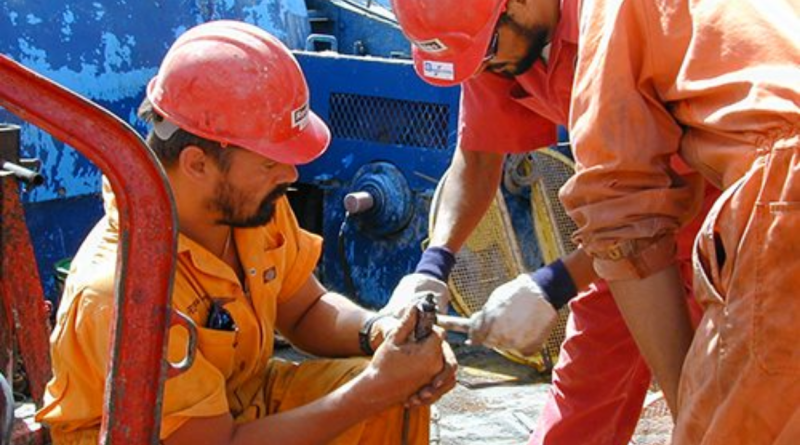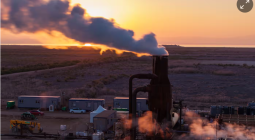Oil Worker’s Shift to Geothermal Reflects ‘Endless’ Opportunity in Clean Careers

An oil sands worker who drilled his way into the geothermal industry is just one example of how the clean energy transition is creating new opportunities for the Canadian work force, now supported by new legislation.
Tyler Bleck, operations director at Ontario geothermal utility Diverso Energy, told The Energy Mix that he started his drilling career in Alberta’s oil sands. He then brought those skills with him to take up a refrigeration HVAC drilling job to stay near home in Ontario, and finally moved to his current role with Diverso, where he’s been for around a year.
There are a tonne of job opportunities in the sector—not just for those with drilling experience, but also for sheet metal workers, plumbers, and mechanics, Bleck said.
“This is a trade—this is a viable opportunity for somebody to come in and have a career for 40 years,” he said. “It’s a great career choice, and the kind of opportunity within it is almost endless.”
Geothermal Gaining Popularity
Drilling is as central to geothermal systems as it is to oil extraction. In a building’s geothermal setup, underground pipes use the ground as thermal mass. For cooling, water flowing through the pipes can transport heat to store in the ground. Or, during winters, it can bring captured ground heat up to warm indoor spaces. In other applications, heat gathered through geothermal systems can also be used to generate electricity.
Such systems are becoming increasingly popular as a clean energy source. Though overshadowed by the breakneck pace of expanding solar and wind generation, Canadian companies have been steadily exploring geothermal technology with investment support from the federal government. Across the border in the United States, the industry recently “hit a milestone” when a California utility backed a new geothermal development capable of generating 400 megawatts of clean electricity.
As the industry grows, it is opening up a job market for people with drilling experience. Bleck said geothermal offers a great opportunity for workers who’ve spent time in oilfields or drilled for the mining industry—as most of his current colleagues have done.
‘Really Good at Drilling Holes’
“These guys are really good at drilling holes, and they’re really good at operating machinery, and they’re really good at making good decisions—they’ve shown that through their history of working in the oilpatch and the years they’ve been doing it, because you won’t survive out there [without a certain level of skill],” he said.
Some aspects of the job are different: Oil sands drilling is all vertical, while geothermal systems require horizontal drilling. And regulations across provinces may vary. In Alberta, they prevent drilling beyond certain depths near cities, while in Ontario drills can go deeper.
The geology is different, too, as a lot of drilling at Alberta’s oil sites is into sand, while in Ontario it requires moving through a lot more “overburden”—the soil or rock that lies over the area being drilled to.
“We have to think about the unseen and the unknown,” Bleck explained. “So you’re very much working by feel—what kind of ground are you in? What are you drilling in?”
“In vertical drilling when you get into rock you’re just in rock—it’s either hard rock or soft, and there’s usually nothing more to it,” he added. “When you’re doing horizontal drilling, you’re always in the overburden—you’re never in rock, or very rarely, anyway.”
But the theories and the principles are the same or relatable overall, he said. Plus differences in specific drilling skills can be taught. The key qualities he looks for when adding people to the team are the same for both industries: a good work ethic, mechanical aptitude, willingness to learn and be flexible, and an ability to think on your feet and make good decisions quickly.
The workers losing their jobs in the Canadian oil industry would likely boast many of those qualities. “From September 2014 through December 2022, the Canadian oil and gas industry cut 19% of its work force—43,548 jobs—due to structural changes and increasing automation,” the Parkland Institute at the University of Alberta wrote in 2023. “About 81% of these job cuts—35,160 jobs—were in Alberta.”
Sustainable Jobs Act
Bleck said he started working in the oil sands for the money, then stayed because he liked the work and the camaraderie. But after seven seasons out west, he decided that spending five or six months a year away from his wife and kids wasn’t cutting it anymore, so he moved back, adapting his skills to similar work.
With the many job opportunities opening up at geothermal companies in the region, Ontarians looking for that kind of work can find it closer to home—and also elsewhere across Canada, he said.
Meanwhile, federal officials are trying to facilitate just this kind of transition for workers amid the shift to a low-carbon economy. Canada recently passed the Sustainable Jobs Act, Bill C-50, which mandates action to ease job transitions and establishes a Sustainable Jobs Partnership Council with non-government representatives for industry, workers, Indigenous peoples, and energy transition experts.
The council will advise the government on policy and program development for the more than two-thirds of Canadian fossil fuel workers who said in a 2021 survey that they are interested in jobs in a net-zero economy. Nearly nine in 10 workers said they want training and upskilling for net-zero employment.
But achieving the objectives of the Act hinges on whether workers can be confident about finding good jobs across sectors—as industries face increasing pressure to meet climate regulation. Though that confidence is critical, it isn’t something lawmakers need to “reinvent the wheel for,” Alex Callahan, director of health, safety and environment at the Canadian Labour Congress, explained at a recent webinar.
Some basic measures—like strengthening employment insurance, ensuring that jobs are available, and offering security for skills training, accreditation, and pensions—will go a long way, he said.
The Sustainable Jobs Act will facilitate workers’ transition into various sectors, but the move from oil to geothermal drilling is as straightforward as it gets. And the switch carries other benefits, Bleck said. Geothermal drilling is often done near cities and residential areas, so the work is more distributed across populated areas, rather than in remote locations. It gives workers the option of a more balanced work-life career—compared to the “feast or famine” work of oil drilling—offering them jobs near home without the burden of travelling away for months at a time.
“We have a significant resource available to us, right now, right here, and we’re just at the base of the mountain as far as I’m concerned,” he said of Ontario. “We’ve been waiting for this and it’s here, and anybody that’s been around for at least 10 years is incredibly excited about it.”





